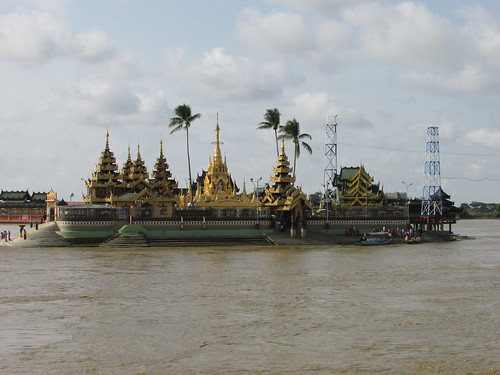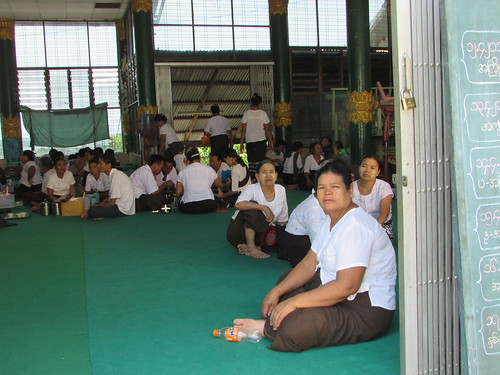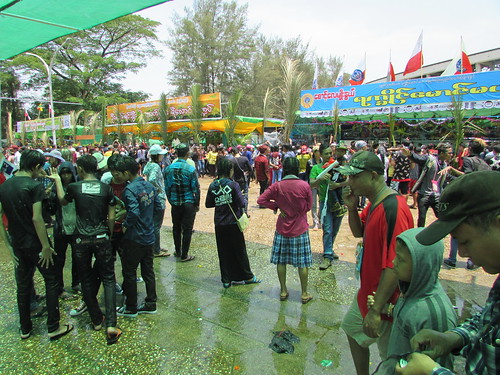The Doctor said that we would visit a pagoda on an island to the south of Yangon. The Doctor, his wife and I set off by car about 7.15 a.m. It took us around an hour to reach Kyauktan, a small town bordering a fast-flowing, muddy river. The small island we could see was completely occupied by the Kyaik Hmaw Won Yele Pagoda and a fleet of gaily-painted elegant wooden ferries was transferring pilgrims from the mainland to the Pagoda.
We discovered that, as a Foreigner, I was only allowed to travel on one of the ‘big boats’, so we had to wait a few minutes for one of these to become available. It featured a roof, plastic moulded seats to sit on and even lifejackets (but lacked the aesthetic appeal of the smaller ferries). It’s often the case in Burma that Foreigners have to pay a premium. Knowing how poor many Burmese are, it’s a cost I don’t resent (and they did provide a lifejacket!).
I’m not a Buddhist, but the devotions of Burmese Buddhists never fail to impress me. We walked around the various temples and I noted the inscribed stone with the Exhortation Verses:-
VERSE 1There was a third rule inscribed but the text was obscured by a display of flowers.
Forbearing patience is the highest moral practice.
“Nibbana is supreme” say the Buddhas.
A bhikkhu does not harm others.
One who harms others is not a bhikkhu.
VERSE 2
Not to do evil
To cultivate merit
To purify one’s mind
This is the teaching of the Buddhas.
Near the water’s edge, a vendor was selling fish food balls to throw to the fish – carp, I imagine, from the violent thrashing of the water but the water was too muddy to see the fish clearly.
 Kyaik Hmaw Won Yele Pagoda.
Kyaik Hmaw Won Yele Pagoda.
We returned to the mainland using the same ‘big boat’ which took us to the island and explored the open market, where the Doctor and his wife made a few purchases. Then it was back to the car and we retraced our outwards route from Yangon. On the outward journey, the roads had been much quieter and the Water Stations had not been throwing water – I gathered that 9.00 a.m. was the usual starting time. But I’d been amused that, even as early as 8.00 a.m., most of the sound systems had already ‘turned it up to 11’ (a reference to ‘This is Spinal Tap’ for the cogniscenti). On the way back, there was heavy traffic principally heading towards Kyauktan with lots of pick-up trucks loaded with happy (and already wet) revellers.
Out in the country, we made a brief stop where the Doctor spoke to a friend who has a business selling bamboo. The versatility of bamboo as a building material is perhaps not fully appreciated in countries which do not produce ‘construction grade’ bamboo. Certainly, all the buildings where we stopped were bamboo-built.
Our next stop was at the Kyaik Khauk Pagoda, Thanlyin where the main pagoda is on a hilltop location, surrounded by extensive monastic buildings. The hilltop was reached by a number of sets of covered steps, in the traditional arrangement I’d seen in many places. Although I made the ascent, I’m slower than I used to be (on my recent trip to Cape Point in Cape Town my right knee suddenly started to aggravate me).
Because of the holiday period, the pagoda was packed, with many groups dressed in the white top and plain brown longyi of the pilgrim. They were likely to spend the whole day at the pagoda and, since a pilgrim’s lunch is traditionally taken before noon, there was a lot of eating going on.
 Pilgrims taking lunch in one of the Prayer Halls.
Pilgrims taking lunch in one of the Prayer Halls.
Over the loudspeaker system, a monk with a particularly mellifluous voice was intoning sacred texts.
The elevated position of the pagoda gave wonderful views in all directions. The skyline of Yangon city is changing as numerous tall buildings, at one time prohibited, are erected.
The new port of Thilawe, with a couple of large cargo ships, was visible. Burma has now taken its place on the cruise liner itinerary, with the ships docking at Thilawe and passengers being bussed into Yangon for a ‘whistle-stop’ tour.
I’d already noticed a separate lift giving access to the hilltop. This was also a feature I’d seen at other important sites (like the Shwedagon and Mandalay Hill) and the Doctor and his wife, concerned for my well-being, suggested we used the lift to descend. However, previous experience meant that I was unsurprised that the lift did not appear to be in general use. I’d spotted the rolled-up red carpet waiting for important visitors and the ‘VIP Lounge’ near the lift, but where’s the Merit in that? I was quite happy to descend (albeit slowly) using the covered steps.
We carried on back to Yangon. The area around the National Stadium in Yangon was very busy and the sound of modern dance music was overpowering. I wondered what event was in progress and the Doctor offered to show me. Apparently, the New Year practices in Rakhine State vary from those generally observed and so, I suspect to raise the profile of the Rakhine people, a water-throwing event had been organised on part of the National Stadium site. It was noisy, it was wet and everybody seemed to be having a great time. There were lines of water-throwing stations and a covered walkway to facilitate seeing it all. However, the roof of the covered walkway had been connected to the water supply and a series of rotating nozzles, like upside-down lawn sprinklers, generously sprayed the pedestrians beneath. There was a wide range of cafes and food stalls and a remarkable number of traders selling all sorts of goods.
 Thingyan - Rakhine Style.
Thingyan - Rakhine Style.
The remainder of our trip back to the Doctor’s home was, of course, punctuated by the car being liberally sprayed with water at the Water Stations we passed but, with the car windows closed, we completed our journey without further soaking.
Related posts
Next post on this trip.
All my posts on this trip can be found here.
My pictures
Kyaik Hmaw Won Yele Pagoda.
Kyaik Khauk Pagoda.
Thingyan - Rakhine Style.
All my pictures on this trip are in the collection Burma, 2016.
[Links to pictures added 7-May-2016]
